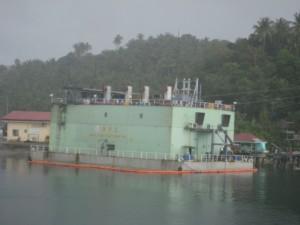 Generating electricity from imported fuels on islands is dirty and expensive. Most islands generate the majority of their electricity using large diesel and bunker fuel generators on offshore barges (see image) where spills can be relatively small but frequent. These dirty fuels are more expensive than on the mainland due to the lack of economies of scale inherent to islands. Whereas a supertanker is needed to supply say, Texas, a much smaller- and less seaworthy- tanker ship is needed to supply the outer islands of Fiji. In an attempt to create economies of scale, island states often sign long term single supplier contracts with oil companies which are vulnerable to corruption.
Generating electricity from imported fuels on islands is dirty and expensive. Most islands generate the majority of their electricity using large diesel and bunker fuel generators on offshore barges (see image) where spills can be relatively small but frequent. These dirty fuels are more expensive than on the mainland due to the lack of economies of scale inherent to islands. Whereas a supertanker is needed to supply say, Texas, a much smaller- and less seaworthy- tanker ship is needed to supply the outer islands of Fiji. In an attempt to create economies of scale, island states often sign long term single supplier contracts with oil companies which are vulnerable to corruption.
Socially, politically, and environmentally islanders are often more sensitive to the environmental impacts of using dirty fuels than the rest of us. Islanders’ livelihoods and existence are far more vulnerable to climate change related sea level rise, increased storm intensity and coral death among other problems, which gives them broader political support to support renewables. Furthermore, island economies disproportionately rely on tourism for income and loud smoke belching diesel generating barges don’t jive with glossy tourist brochures. Politically, both sovereign and non-sovereign states can use the power of the state to sponsor renewable development and coalitions between states. The Small Island Developing States (SIDS) can pool resources and develop human capital for energy projects. Even non-sovereign islands (like Hawai’i) have a degree of political independence from the mainland regarding energy policy.
Because of the high costs described above, the economic, environmental and socio-political bar is set much lower for renewables to compete with conventional fuels on islands. However, the real opportunity lies in the native renewable potential of the islands themselves:
Islands formed from geological hotspots like Hawai’i and Iceland, and the thousands of islands in that make up Indonesia and the Philippines lying on the Ring of Fire by their nature are located on active geothermal zones which can be tapped for baseline geothermal electricity generation; islands on the trade winds can take advantage of steady wind resources; tropical islands by definition inherently have consistent solar radiation which can be used for active (expensive) or passive (dirt cheap) solar systems or for biofuel cultivation; and wave and tidal technologies have strong potential to supply clean energy to islands.
Currently islands in the developed world (Denmark, Iceland) have showcased renewable energy potential in terms of percentage of electricity generated, but less developed islands are not too far behind and new projects are breaking ground regularly. The need for small custom energy systems and the sheer number of islands that need them means greenfield opportunities– and a nice place to work– for developers!

